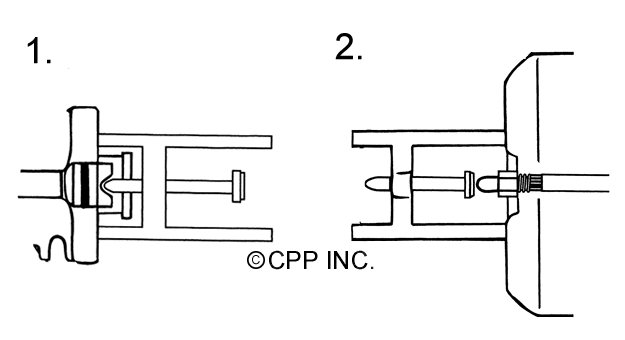
 |
|
|
#1 |
|
Registered User
Join Date: Apr 2014
Location: Denver CO
Posts: 26
|
soft brake pedal
I have a 66 with disc brakes all around, booster, prop valve. I have bled the brakes to a descent pedal with the truck is not running. When running, the pedal is weak. If you pump the pedal while running it will build and stop the truck but not effectively. there are no leaks.
Side note: the piston coming out of the booster is not to far out so I know it's not engaging the master cylinder. any idea what the problem could be? Thanks! DMO |
|
|

|
|
|
#2 |
|
Registered User
Join Date: Aug 2009
Location: Bowser
Posts: 13,751
|
Re: soft brake pedal
Did you change your pedal ratio?
Power needs 4.5 to 1. Stock is usually 6 to 1. Might need another rod attachment hole drilled in your pedal arm about 1 1/2 inches lower. |
|
|

|
|
|
#3 |
|
Moderator
  Join Date: Aug 2011
Location: China Spring, TX
Posts: 7,280
|
Re: soft brake pedal
This may help. (from CPP site http://www.classicperform.com/TechBo...oubleshoot.htm )
Check Booster Pushrod Adjustment The pushrod that actuates the master cylinder must be properly adjusted. Ideally there should be only slight clearance between the booster pushrod and the master cylinder pushrod. Interference will preload the master cylinder. When the system is preloaded, it builds pressure each time the pedal is pressed. Since the master cylinder is not allowed to fully release the pressure from the previous stroke, the system will eventually lock the wheels. Too much clearance will cause excessive freeplay in the pedal. In almost every case, if you bought your booster and master cylinder from us, we pre-adjust the booster pushrod and master cylinder for you so this is not a problem. To make 100% certain of a properly adjusted booster pushrod for your master, we offer a master cylinder depth gauge (PN: CP2003) to determine correct pushrod length. The following illustration demonstrates the proper usage of this tool. First measure the length that the booster pushrod extends past the face of the booster with the "head" of the pin. on the tool. Then measure the depth of the master cylinder piston with the other end of the pin on the tool. If the pin hits or there is too much space on step two, then adjustment is necessary.  There are basically two different master cylinders that we use for our Chevy and Ford kits, the Deep Bore master cylinder and the Shallow Bore master cylinder. To determine which master cylinder your booster is setup to mate with, you can do the following simple check. For Shallow Bore master cylinders, the pushrod should be approximately flush with or below the booster face. Deep Bore master cylinders will protrude past the face of the booster body by about 1" to 1-1/2". Note that Deep Bore master cylinders are required for manual brakes and Shallow Bore master cylinders are generally used for power brake systems. We now supply a master cylinder piston adapter to accommodate both master cylinders. You will only use this adapter when you have a Deep Bore master cylinder with a short booster pushrod.  Hope that helps.
__________________
Master Chief, US Navy, Retired 1964 C10 Step-side Short Bed - In Progress 2009 2500HD Duramax LTZ 1948 GMC Panel 1956 Big Window Stepside 1953 5 Window Chevy Stepside 1932 Coupe New Seat Foam for Bench Seats? |
|
|

|
|
|
#4 |
|
Registered User
Join Date: Apr 2014
Location: Denver CO
Posts: 26
|
Re: soft brake pedal
I have a deep bore MC and the push rod coming out of the booster was not long enough en engage the MC. I was able to unthread the stock push rod and locate a bolt long enough to engage the deep bore. Does this create another problem? through trial and error I have made sure the push rod does not come in contact with MC.
|
|
|

|
 |
| Bookmarks |
|
|